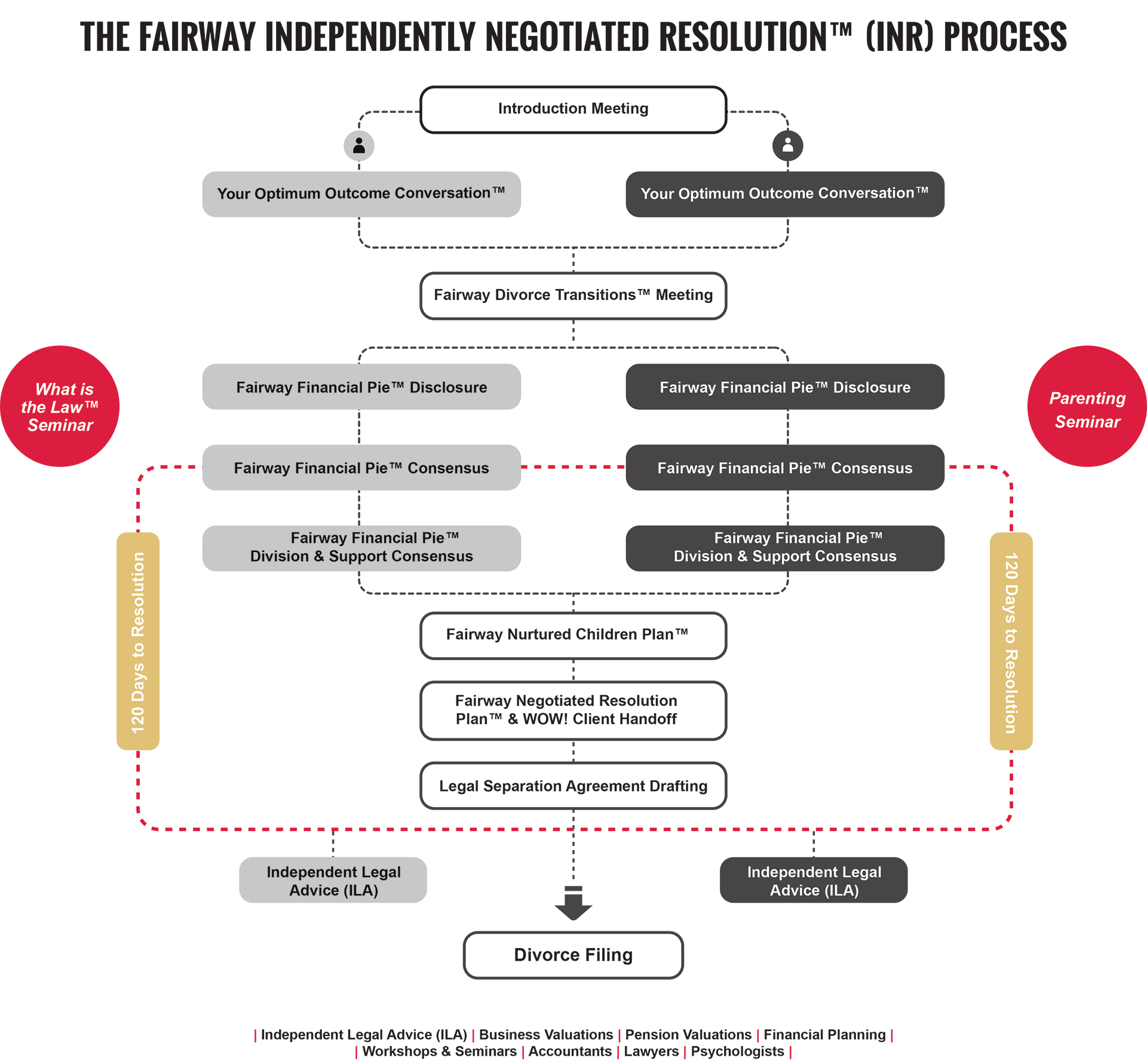Negotiating spousal support terms; payment or receipt.
Spousal support, or alimony or maintenance, is the legal obligation for one person to provide an ex-spouse financial support after a marital breakdown or separation. Many factors and calculations affect the amount or whether an ex-spouse is entitled to spousal support payments after a separation or divorce.
Calculating spousal support
The outcomes for spousal support usually fall within the range set out by the federal support guidelines. Most, if not all, professionals, whether lawyers or mediators, will refer to the guidelines when determining support. Professionals use two standard software programs in Canada: Child View and Divorce Mate. While both drive the same results, some provinces use more of one than the other.
The challenge in calculating spousal support
 Spousal support is typically the most contentious part of the divorce negotiations. Stress and fear can escalate quickly, resulting in a conflict that could end up in court. Outcomes can vary depending on several factors, so it is imperative to take the time and effort to resolve this in a way that sets both of you up for success. Several factors to consider include:
Spousal support is typically the most contentious part of the divorce negotiations. Stress and fear can escalate quickly, resulting in a conflict that could end up in court. Outcomes can vary depending on several factors, so it is imperative to take the time and effort to resolve this in a way that sets both of you up for success. Several factors to consider include:
- Length of marriage and age of spouses
- Occupations and education of each person
- Dependent Children
- Structure of income: dividends, bonus,
- Self-employed or employee
- Duration of employment and stability
- The ability of the person receiving support to re-educate and work
- Differences in income when both employed or income earners
- Sacrifices during the marriage (career, children etc.)
- The person's behaviour is irrelevant (i.e., affairs or emotional abuse), so do not waste time and money arguing about bad behaviour.
Types of spousal support
Whether you are paying or receiving, you can structure the payments in a way that works for you.
There are typically two approaches to paying spousal support. The first is a fixed amount, and the second is a variable. Variable payment means that the amount paid can and will vary. If the parties cannot agree on a set number for a fixed period, the default is to make the married support variable. Typically, in the case of variable spousal support, the separation agreement will set out how often and under what circumstances support will be recalculated. Also, to avoid expensive negotiations, many contracts will attempt to set the spousal support amount for a couple of years to prevent yearly renegotiation.
Spousal support payments may also be a fixed amount. The separation agreement will detail the amount that will be paid monthly and the duration of time. In some separation agreements, there is an option to renegotiate if a material change exists for one of the parties. In others, there may be no option for renegotiation. Typically, the courts are hesitant to order fixed spousal support.
Negotiating spousal support so you feel like you have control and it is fair.
 Independently Negotiated Resolution™ (INR). Emotions matter, but they shouldn't affect your intelligent decision-making. We use a proprietary step-by-step process (INR™) that centers on making decisions about finances and co-parenting vs. creating a circus of using affidavits and legal applications that often focus on non-factual differences of opinion.
Independently Negotiated Resolution™ (INR). Emotions matter, but they shouldn't affect your intelligent decision-making. We use a proprietary step-by-step process (INR™) that centers on making decisions about finances and co-parenting vs. creating a circus of using affidavits and legal applications that often focus on non-factual differences of opinion.
At Fairway, almost all divorce-related matters can be resolved outside of the traditional litigious system. To achieve an outcome that is fair requires that the two parties set aside their emotional differences and deal with the financial issues pragmatically. If a couple can do this, the spousal support negotiations can happen smoothly while achieving a resolution that works for both parties. Being involved in a contentious legal battle, where there are scare tactics and threats flying back-and-forth, does not accomplish anything positive for either party. It is also vital that both parties continue to be motivated to work and generate income. The only way this will likely happen is if both parties feel they have input into the structure of spousal support.
At Fairway Divorce Solutions, we have helped thousands of couples achieve a win-win regarding spousal support and believe that this is achievable for most parties. Our model is designed to navigate and facilitate resolution in a way that maintains your integrity and protects both your outcomes and relationships, mainly when children are involved. Ensuring you are a well-educated and empowered decision-maker is Fairway's goal.
We Help with Spousal Support.
Fairway can keep you out of the courts and help find a solution minus the costly lawyer fees.
Getting a divorce through the traditional system takes an average of 3 years in Canada and that does not include if you have to involve courtroom litigation.
Client testimonials
Success comes in many forms. For us, it is hearing back from our clients and reading how we have changed their lives for the better. These stories are the reason we do what we do.

We had an excellent experience with Fairway, Negotiation and Mediation are far less expensive and far more efficient than litigation. Fairway has brilliant facilitators that help couples navigate through a complicated emotional process.
- Fairway Client, January 2020
The Unique Fairway Method
Divorce is difficult. We make is easier from start to finish. The Clear Road to a New Life®

Fairway Divorce Solutions meets your needs
Locations
Helping Canadians with divorce mediation since 2006, with more than 25 Divorce Resolution Mediators in more than 11 locations.
Head Office
Head Office
Manitoba
WinnipegAlberta
Airdrie Calgary Edmonton Southwest Edmonton Northwest Okotoks Red Deer Medicine Hat Edmonton East Lethbridge Sherwood Park Grande Prairie Fort McMurray Leduc Fort SaskatchewanOntario
Waterloo WellingtonSaskatchewan
SaskatoonFrequently asked questions
Neither the federal Divorce Act, nor provincial legislation set out an expected amount or duration of spousal support. The national child support and spousal support guidelines are the law that pertains to child support but not with regards to spousal support. Many lawyers and divorce specialists do apply the spousal support guidelines when negotiating or representing their clients. The courts, however, have jurisdiction and can award spousal support based on their discretion. The outcomes for spousal support usually fall within the range as set out by the federal support guidelines.
Typically, lawyers, arbitrators, mediators, and other divorce specialists use the spousal and child support calculators to set the starting point for negotiations around spousal. As would be expected, if you are using lawyers, there is a tendency to start either at the high or low range depending on whether you are the payee or payor. There are two common software that professionals use in Canada, Child View and Divorce Mate. While both drive the same results, some provinces use more of one than the other. The outcomes, however, should be the same regardless of which software. There are also online calculators available to the public.
With spousal support, there is no simple rule for length of time or the amount paid. The extent of payments usually relates to the number of years of marriage. While there are differences across the provinces, within a province there is reasonable consistency with the outcome. If you are in a long-term marriage, meaning more than 20 years, then guidelines do set out that payments may be indefinite. There are significant variations on what the definition is of forever. Given the complexity and the variability of outcomes with regards to spousal support, getting independent legal advice is prudent.
There are typically two approaches to paying spousal support. The first is a fixed amount and the second is variable. Variable payment means that the amount paid can and will vary. If the parties are unable to agree on a set number for a fixed period, the default is to make the spousal support variable. Typically, in the case of variable spousal support, the separation agreement will set out how often and under what circumstances support will be recalculated. To avoid expensive negotiations, many agreements will attempt to set the spousal support amount for a couple of years to prevent yearly renegotiation.
Spousal support payments may also be a fixed amount. The separation agreement will set out in detail, the amount that will be paid monthly as well as the duration of time. In some separation agreements, there is an option to renegotiate if there is a material change for one of the parties. In others, there may be no option for renegotiation. Typically, the courts are hesitant to order fixed spousal support.
The other type of fixed spousal support is a lump sum. In this case, the present value of future payments is calculated taking into consideration tax. While this is attractive, as it brings closure with regards to spousal support, many are not able to afford this type of option.
Regardless of whether it is variable or fixed, there are pros and cons to each with risk and reward, and these need to be carefully considered. Having a third-party help evaluate the options, taking into consideration careers, financial security, and personal needs, can help parties come up with a solution that works for everyone.
There is no surprise that spousal support is one of the most significant areas of contention in divorce and can result in conflict, and if you are not careful, substantial legal bills.
There are some determining factors when it comes to deciding if spousal support should or will be paid. A few factors considered when determining if it should be paid include; the amount of time a couple lived together, if there were any previous arrangements, e.g., prenuptial or cohabitation agreement, as well as the responsibilities each partner had during the marriage. In the case of common law, spousal support may be awarded. The factors considered would be similar to a common-law couple; however, this is more complicated due to the lack of clear precedents across the country.
The CRA sets out that periodic spousal support payments are deductible to the payor and considered income to the receiver. If a one-time lump sum is being paid, this is received tax-free by the recipient and not deductible for the person paying.
Spousal support is often the most contentious and feared topic of all matrimonial negotiations. This area is complicated, and the results can vary depending on negotiations or a Judge’s ruling. Regardless of what you have read or what you hear, the outcome is likely going to be within the ranges set out by the federal support guidelines. You can choose to use a lawyer who represents you and will work to negotiate an outcome. However, that outcome is likely going to be within the range of the spousal support guidelines and will not be where you and your lawyer started. The other option is to work with a third-party who is a neutral or mediator, who can focus on achieving an agreement for spousal support that works for both parties. You want it structured to ensure that the payor is motivated to continue working and earning an income.
When it comes to spousal support, judges and family lawyers use the federal Spousal Support Advisory Guidelines for decision-making. While the guidelines are not law, they suggest appropriate amounts as a range set to award when making orders and agreements related to spousal support. The courts, however, have jurisdiction and can award spousal support based on their discretion. Many lawyers and divorce specialists apply the spousal support guidelines when negotiating or representing their clients. The guidelines do not intend to address entitlement; in any case, entitlement to support depends on how the law applies to their situation.
While the legislation does not specify a specific method for calculating spousal support, there are a number of tools available that help calculate amounts, including those that consider budgets and utilize the federal Spousal Support Advisory Guidelines. Two commonly-used software that professionals use in Canada are ChildView and DivorceMate. Some provinces use one more than the other; however, the results are the same regardless of the software. There are also online calculators available to the public.
With spousal support, there is no simple rule for the length of time or the amount paid. The Spousal Support Advisory Guidelines connect the duration of support to the length of the relationship or the time when the youngest child starts/completes full-time school (up to grade 12). While there are differences across the provinces, within a province, there is reasonable consistency in the outcome. If you are in a long-term marriage (meaning more than 20 years) then guidelines do set out that payments may be indefinite.





